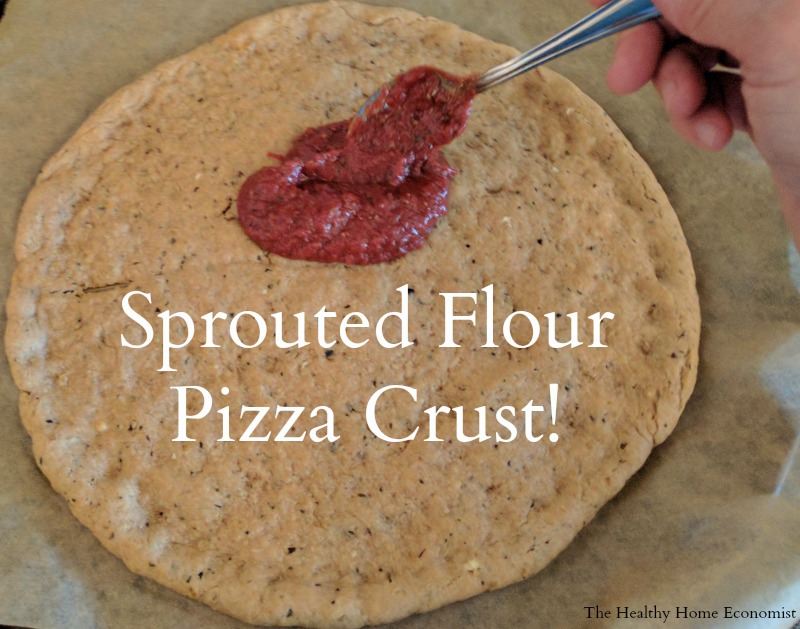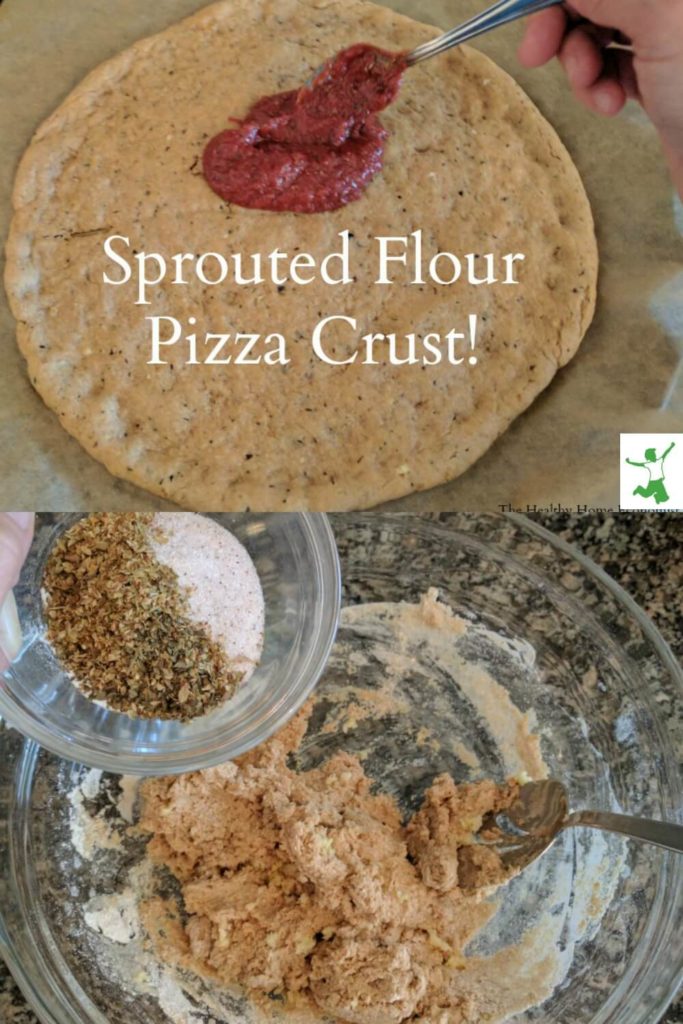
China is credited with developing the method for germinating seeds many centuries ago. On long ocean voyages, Chinese sailors used sprouted mung beans as a source of vitamin C for preventing scurvy. Vitamin C is produced in significant quantities when you sprout seeds and many other nutrients are increased substantially including the B vitamins and carotene.
Probably the best aspect about sprouting is that it renders the grain significantly more digestible as well as nourishing.
Phytic acid and complex carbohydrate molecules which cause intestinal gas are broken down. Sprouting also inactivates aflatoxins which are carcinogens found in grains.
How to Source Sprouted Flour for Pizza Crusts
You have 3 options for obtaining sprouted flour in your home when you are ready to give it a go:
- Buy sprouted flour. Buying already sprouted and ground sprouted flour is the easiest and quickest option. See my Resources page for producers of quality sprouted grains of all kinds.
- Grind sprouted grain you purchased. This is a good option if you have a grain grinder and want the freshest flour possible but don’t have time to do the sprouting yourself. Again, my healthy shopping guide lists vendors of sprouted, unground grains.
- Sprout the grain yourself and then grind it. This is the option that takes the most time and is the most economical. If you have the inclination to learn how to sprout yourself, you can learn what to do from the videos on sprouting flour I have filmed.
I would suggest that sprouted flour pizza crust be your first dish to try. Making sprouted flour pizza crusts is easy, and it is fun to work the dough with your hands. The kids can get involved with this task when you make pizza for dinner.
With all the toppings on top of the savory sprouted flour pizza crust, the slightly different but very enjoyable taste sprouted flour imparts to the grain will be less noticeable and easier to get used to for young eaters who notice any and all differences at the dinner table!
Sprouted Flour Pizza Crust Recipe
Backside Bonus: Sprouted flour is much more filling that unsprouted flour, so don’t be surprised if you can only eat one or two slices of sprouted flour pizza where you could eat more with an unsprouted crust!
If you would like to try other healthy pizza crust variations, this grain free recipe for almond meal pizza crust is delicious and simple to make. Just be sure the almond meal is properly prepared to reduce the digestive risks from anti-nutrients.
Or, you can try coconut crust pizza, which is also grain free. No special preparation is required for the coconut flour.
If you are simply avoiding wheat, try this recipe for gluten free pizza crust instead.
Tip: This healthy pizza makes a great lunchbox item that most everyone will enjoy!

Sprouted Flour Pizza Crust
Easy to make sprouted flour pizza crust recipe to add nutrition and digestibility to your homemade pizza. Makes 2 – 13″ pizza crusts.
Ingredients
- 2 cups sprouted flour
- 1/2 cup parmesan cheese shredded
- 2/3 cup whole milk
- 1/4 cup expeller pressed coconut oil
- 2 Tbl extra virgin olive oil
- 1 tsp dried basil
- 2 cloves garlic crushed
- 1 tsp dried oregano
- 1 tsp onion powder
- 2 tsp aluminum free baking powder
- 1 tsp sea salt
Instructions
-
Preheat oven to 375 F/190 C. Mix all sprouted flour pizza crust ingredients in a bowl with your hands until the dough pulls away from the sides of the bowl. Gather dough together with your hands and press into a ball.
-
Knead dough in bowl 10 times to make smooth then divide dough in half. On lightly floured surface roll each half into a 13 inch circle. Place on pizza pan (use parchment paper to cover if you have only aluminum ones). Turn up edges 1/2 inch and pinch.
-
Brush circles with 2 Tbl of olive oil.
-
Bake sprouted flour pizza crusts for 10 minutes. Remove from oven and add add desired toppings. Try this easy, no cook pizza sauce. Bake for 5-10 minutes until it looks done.
-
Serve and enjoy!
-
Refrigerate any leftovers you may not have used. This pizza crust will last for several days in the refrigerator, and you can even freeze it if you desire to make pizza at a later date.









Thank you for sharing! You are right, pizza doesn’t have to be considered junk food. It’s only junk food if you use “junky crust” and top it with junk. My favorite pizza is topped with simple ingredients like basil, tomatoes, goat cheese or fresh mozzarella, artichokes and chicken.
Can you do one for Gluten free?
absolutely! and even if you load it with naughties, it’s still better for you than take out or frozen b/c there’s no chemicals/preservatives and you know where the dough’s been! lol
Sarah,
We just love this recipe for our weekly pizza! I absolutely love the flavor that the Parmesan cheese and herbs give it. I do not miss the yeast in this crust at all! The outside edges taste like a cheese cracker. Made it tonight and just thought I would thank you for this great “go to” crust. Sprouting the wheat berries are worth the effort just for this one recipe!
would this recipe freeze well?
we do pizza every week but would only use one. otherwise I assume I can just halve the recipe? 🙂
My daughter is allergic to coconut. Can recommend a substitute for the coconut oil?
I’ve learned so much from your site and am so happy that you keep this blog. We are sprouting our grain at home and dehydrating it, and finally grinding into flour. It’s amazing the difference it makes with digestion! Love this Pizza recipe. It’s one of our favorites now!
I’m curious about brushing the crust with olive oil. Won’t that turn into a trans fat when it’s heated? Or does it not get hot enough for long enough for that to happen? Thanks.
Great, great recipe! We loved it. Followed the recipe exactly, except used coconut milk instead of whole milk. Can’t believe how easy it is to make!
thanks for the video, I am going to sprout tonight! Now, when I am ready to bake with the flour, which is in the freezer, do I need to soak, or does sprouting eliminate the soaking process.